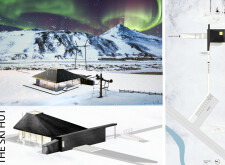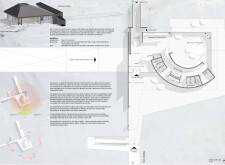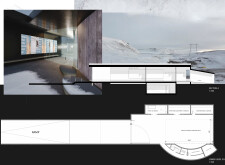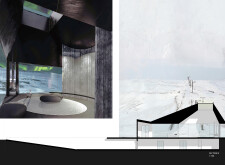5 key facts about this project
## Architectural Analysis Report: The Ski Hut Project
### Overview
Situated in a mountainous region renowned for winter sports, the Ski Hut serves as a shelter and visitor center for skiers and outdoor enthusiasts. Designed to enhance the engagement with the surrounding alpine landscape, the project integrates functionality with an awareness of environmental context. The architectural form features a distinctive roofline that mirrors the nearby hills, establishing a visual connection with the terrain and serving as a cultural landmark within the area.
### Spatial Organization and User Experience
The interior layout emphasizes user functionality and experience, facilitating smooth transitions among various zones. The primary visitor entrance and lobby serve as welcoming access points, leading to a centrally located refreshment station that fosters social interaction. Additional areas include changing facilities and washrooms for user convenience, alongside a dedicated equipment tuning station tailored for skiers. Communal resting areas are oriented toward scenic views, enhancing opportunities for reflection and socialization amidst the natural surroundings. External features, such as a viewing deck and direct access to ski lifts, further encourage interaction with the landscape while supporting outdoor activities.
### Material Selection and Sustainability
The material palette of the Ski Hut reflects durability and aesthetic coherence with the rugged environment. Precast concrete provides structural stability and thermal mass, while dark metal siding enhances weather resistance and durability. Acetylated wood siding introduces warmth and texture, contrasting with the metal façade to create an inviting exterior. Prefabricated metal trusses support the unique roof structure, enabling efficient construction without compromising strength. Sustainable practices are evident in the design's integration of passive heating and cooling systems, retractable glass panels for solar gain, and rainwater harvesting, establishing a commitment to ecological responsibility while ensuring energy efficiency.






















































